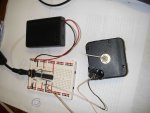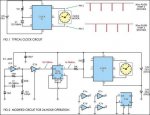The standard quartz clock motor seems to be some sort of stepper but with only one coil. The rotor has a single north south permanent magnet in it and the coil is briefly pulsed with polarity reversed on alternate pulses. So in that sense it is a bit like driving one coil of a bipolar stepper and I am using half an L293D to drive it. It was easy to cut the circuit tracks and solder some leads on which exit the case through small drilled holes.
The direction is apparently controlled by the shape of the pole pieces (maybe a bit like a shaded pole motor). However I have found that the following set up can give stable running in both directions. By stable I mean if you try and reverse the second hand it just stops and then continues in the required direction. Torque seems about the same in both directions.
Applying a pulse of 6ms and then waiting 500 ms before applying the next (reversed) pulse results in anti clockwise motion. Increasing the pulse to 25ms results in clockwise movement. The wait time can be reduced to 100ms and still give reliable operation.
This may be useful for those wanting a meter type display as the quartz kitchen clock is cheap and often the paper dial is reversible allowing another scale to be easily added.
Is a direct drive from an 08M possible ? maybe a pair of 2.5V zener diodes in series across the 4.5V supply with one end of the coil going to the mid point. The other end of the coil would go to an 08M pin. With the pin as an input no current would flow but with it high or low current would flow through the coil. Could this work and is some protection against inductance needed ?
The direction is apparently controlled by the shape of the pole pieces (maybe a bit like a shaded pole motor). However I have found that the following set up can give stable running in both directions. By stable I mean if you try and reverse the second hand it just stops and then continues in the required direction. Torque seems about the same in both directions.
Applying a pulse of 6ms and then waiting 500 ms before applying the next (reversed) pulse results in anti clockwise motion. Increasing the pulse to 25ms results in clockwise movement. The wait time can be reduced to 100ms and still give reliable operation.
This may be useful for those wanting a meter type display as the quartz kitchen clock is cheap and often the paper dial is reversible allowing another scale to be easily added.
Is a direct drive from an 08M possible ? maybe a pair of 2.5V zener diodes in series across the 4.5V supply with one end of the coil going to the mid point. The other end of the coil would go to an 08M pin. With the pin as an input no current would flow but with it high or low current would flow through the coil. Could this work and is some protection against inductance needed ?
Attachments
-
270.3 KB Views: 94



